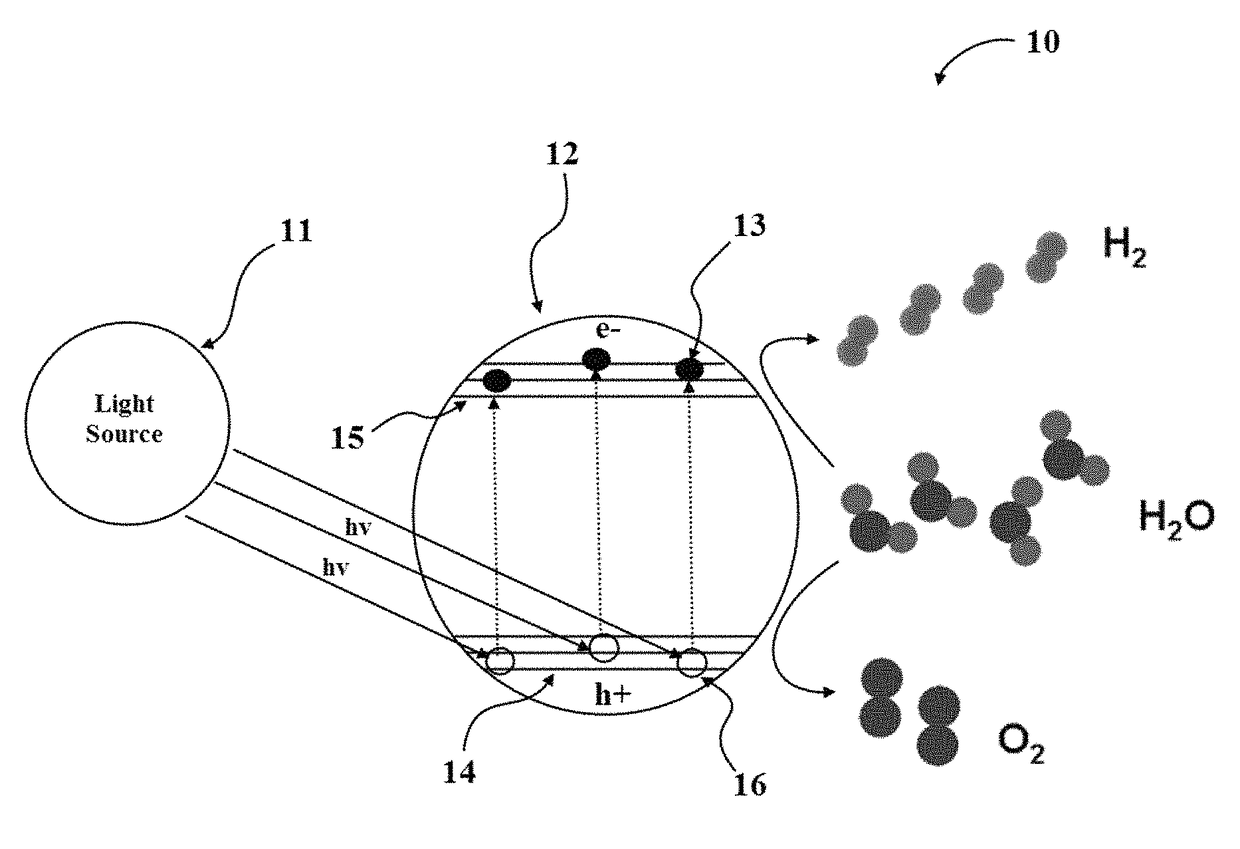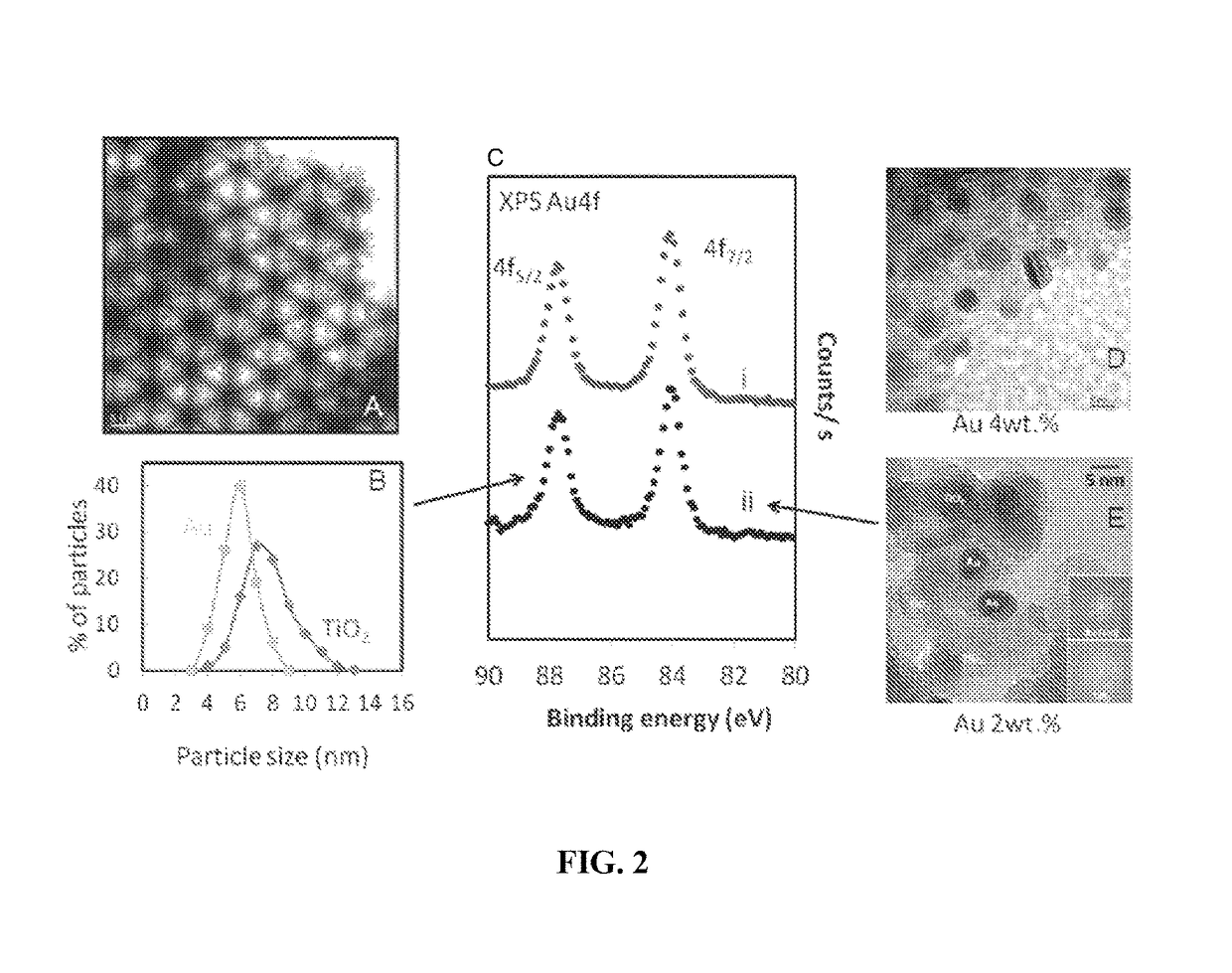Hydrogen production from water by tuning the photonic band gap with the electronic band gap of a photoactive material
a technology of electronic band gap and photoactive material, which is applied in the direction of metal/metal-oxide/metal-hydroxide catalyst, oxygen/ozone/oxide/hydroxide, etc., can solve the problems of inability to achieve the effect of reducing or suppressing the recombination rate of electron-holes, reducing reliance, and reducing the effect of recombination ra
- Summary
- Abstract
- Description
- Claims
- Application Information
AI Technical Summary
Benefits of technology
Problems solved by technology
Method used
Image
Examples
example 1
Materials and Methods Used to Prepare, Test, and Characterize Photocatalysts
[0054]TiO2 inverse opal powders with macro pore diameters (D) of 200 nm or 320 nm, and photonic band gaps along the [111] direction in air of 357 nm and 585 nm, respectively, were fabricated by the colloidal crystal template technique. Colloidal crystals composed of mono-disperse PMMA colloids (diameters 235 nm or 372 nm, respectively) were prepared using a flow-controlled vertical deposition method (Zhou, et al., 2005; Zhou, et al., 2004) to deposit a PMMA colloidal crystal film on a planar substrate and then infiltrated with a TiO2 sol-gel precursor. Careful drying and calcination of the resulting TiO2 / PMMA (polymethylmethacrylate) composites selectively removed the PMMA template, yielding 3-dimensionally ordered macroporous TiO2 inverse opals supports. Gold nanoparticles were subsequently deposited on the TiO2 inverse opals supports using the deposition with urea method (Cushing, et al., 2012). The obtain...
example 2
Data
[0062]FIG. 2 presents transmission electron microscopy (TEM), high resolution TEM (HRTEM) and X-ray photo electron spectroscopy (XPS) of two PBG catalysts (PBG-357 nm and PBG-585 nm). The properties and composition of Au / TiO2 catalysts, where the TiO2 is present in the anatase form, are given. The 3-dimensionally ordered macroporous structure of the PBG materials is clearly seen in FIG. 2A, and the anatase TiO2 crystallites (analyzed by X-ray diffraction (XRD)—not shown) and Au nanoparticles are seen in FIGS. 2D and E. The particle size distribution of both TiO2 and Au are presented in FIG. 2B; both components (Au and TiO2) are of comparable size with the Au particles smaller. Au4f XPS indicates that Au is present in its metallic form with no apparent charge donation from / to the semiconductor to the metal. The Au / TiO2 (PBG-357 nm) and Au / TiO2 (PBG-585 nm) catalysts prepared in this study are near identical in their chemical compositions as well as their main characteristics (par...
example 3
Anatase / Rutile Ratio and Photocatalytic Performance
[0078]A series of three-dimensional ordered macroporous (3DOM) TiO2 (pure anatase) was prepared in order to study its photo-catalytic activity in the context of the present invention. These materials were prepared in the manner outlined above with respect to Example 1 and were confirmed to have overlapping electronic band and photonic band gaps. All prepared catalysts had a fixed loading of 0.50 wt. % Pd and 1.00 wt. % Au. The materials were initially made of TiO2 anatase of particle size of about 10 nm.
[0079]The objective was to test the activity of these materials as prepared as well as that after heating to high temperature (prior to the bimetal deposition). The objective of heating these materials was to transform part of the anatase phase to the rutile phase and exploit their potential synergistic effect on the reaction. See Synergism and photocatalytic water splitting to hydrogen over Pt / TiO2 catalysts: Effect particle size. B...
PUM
| Property | Measurement | Unit |
|---|---|---|
| particle size | aaaaa | aaaaa |
| size | aaaaa | aaaaa |
| size | aaaaa | aaaaa |
Abstract
Description
Claims
Application Information
 Login to View More
Login to View More - R&D
- Intellectual Property
- Life Sciences
- Materials
- Tech Scout
- Unparalleled Data Quality
- Higher Quality Content
- 60% Fewer Hallucinations
Browse by: Latest US Patents, China's latest patents, Technical Efficacy Thesaurus, Application Domain, Technology Topic, Popular Technical Reports.
© 2025 PatSnap. All rights reserved.Legal|Privacy policy|Modern Slavery Act Transparency Statement|Sitemap|About US| Contact US: help@patsnap.com



